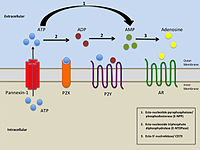
Photo from wikipedia
AIMS Bisphenol A (BPA) has been shown to induce liver fibrosis in rodents. Therefore, this study examined the protective effect of a triple combination of curcumin, n-acetyl cysteine (NAC) and… Click to show full abstract
AIMS Bisphenol A (BPA) has been shown to induce liver fibrosis in rodents. Therefore, this study examined the protective effect of a triple combination of curcumin, n-acetyl cysteine (NAC) and propolis extract against BPA-induced hepatic fibrosis. METHODS 100 wistar male rats were equally assigned into 10 groups; one group was designated as control. 90 rats were gavaged with BPA (50 mg/kg/day) for 8 wk. 10 rats were left un-treated (BPA group). The remaining rats were divided into 2 models. Protective model: rats were co-treated with BPA and curcumin or NAC or propolis or their combination for 8 wk. Preventive model: rats were treated 4 wk before BPA administration and then in the same manner as protective model. Cur group: received Curcumin (100 mg/kg/day, p.o). NAC group: administered NAC (150 mg/kg/day). Prp group: received propolis extract (200 mg/kg/day, p.o). KEY FINDINGS Current treatment interventions significantly alleviated BPA-induced hepatic damage and fibrosis. They also restored pro-oxidant/antioxidant balance, shifted cytokine balance towards the anti-inflammatory side, decreasing interleukin-1β/interleukin-10 ratio. Moreover, these compounds seem to exert anti-apoptotic effects by increasing the immunoexpression of B-cell lymphoma 2 in hepatocytes and decreasing hepatic caspase-3 content. Finally, they ameliorated extracellular matrix turn over through down-regulation of matrix metalloproteinase-9 and up-regulation of tissue inhibitor of matrix metalloproteinase-2 genetic expression. SIGNIFICANCE Current treatments guarded against BPA-induced hepatic fibrosis due to their antioxidant, anti-inflammatory and anti-apoptotic properties, decreasing extracellular matrix turnover. Interestingly, triple therapy provided superior effects to monotherapy. Besides, prophylactic treatments seem to be more effective than concurrent treatments.
Journal Title: Life sciences
Year Published: 2020
Link to full text (if available)
Share on Social Media: Sign Up to like & get
recommendations!